#(all comments from crunchyroll comment section for episode 15)
Explore tagged Tumblr posts
Text








golden kamuy sure is an anime
18 notes
·
View notes
Text
Back on Black Clover again
I keep watching an episode or two and abandoning this anime for months because the few episodes I watch are so, so bad. This pattern continues with episode 40, the ugliest beach episode I have ever seen in my life.



Distractingly off-model animation aside, this episode was jam-packed with everything I completely hate about Black Clover: The Black Bulls, and the insufferably 1-dimensional characters therein acting out their tired, unfunny tropes while screaming and interrupting each other constantly. It honestly started to feel like I was watching a Collins Key video, which might be one of the harshest criticisms I have given anything on this blog thus far.
I am baffled by this anime’s high score on MAL. I can’t parse if this title just has a lot of die hard fans giving it 10’s out of spite/delusion/irony, or if somehow Black Clover eventually becomes something genuinely good in its 170 episode runtime. Reading reviews offers no actual insight – claims it’s “the best written modern shounen” are completely absurd and penned by people that have watched even less than I have, and most reviewers giving it a 10 concede it’s a shameless copycat of various works that came before but that “the author is trying” even if the studio is ruining it with awful animation... so somehow that makes it a masterpiece? Is something pitiable seriously worth an 8.14? Make it make sense…
Then there are my own sensibilities to account for: I think Black Clover is the most misogynistic shounen series I have picked up since I checked out Fist of the North Star (which was made in the 80’s). I think it is wildly immature and its fear of indulging any story beat that is too heavy or too serious is frustrating. In 40 episodes I cannot remember an episode or a scene from Black Clover that left an impression or felt at all formative – I can still remember multiple scenes that make me feel something from pre-shippuden Naruto that I saw over 15 years ago on TV as a child. And that series is far from perfect, but at the very least it knew how to stop and let its characters breathe and feel their feelings and take something seriously. How the hell are we going to have this (extremely, pathetically basic) Teamwork Makes The Dreamwork theme in Black Clover when our protagonist group of misfits don’t seem to give a damn and don’t have to put any work into staying together?
It all just feels so lazy. Everyone’s together because they were assigned to be in a team because they’re all the same and they’re all a joke. Noelle is the only outlier because she is a royal but that doesn’t matter at all anymore because her only character trait is having a huge tsundere crush on Asta that somehow renders her just as “defective” as the other freaks. It has been such a let down honestly that Noelle turned into a willing member of the Black Bulls so quickly because she was like… the only person in the entire team that could facilitate some character drama. But no. She girl. Rich girl like dumb dumb country boy. Dumb dumb country boy say classism bad. Rich girl go ooga booga.
Literally had my head in my hands this episode while Noelle begged Asta to look at her in her bikini. They have massacred my girl. And every other girl in the series thus far.

sasuke_stanpdf you're the only person in the Crunchyroll comment section of episode 40 of Black Clover that even remotely understands my pain. Thank you.
The new OP made my skin crawl because it looks like we’re going into a Black Bull centric arc. (And because the digital zooms looked bad. Sorry.) But maybe the group will actually do something interesting. Better yet, maybe their characters will be challenged somehow. Maybe they will even have conflicts with each other! What a treat that would be in this barren wasteland of a narrative. And maybe, just maybe, Gauche will finally die. Surely, there will be a light at the end of the tunnel that is this arc, right…?
#:Black Clover#black clover#say yes. say Yes something will happen character wise Preston we promise#also Licht is the only light in this series To Me <2
3 notes
·
View notes
Text
FEATURE: *Updated* Every Time Subaru Dies in Re:ZERO -Starting Life in Another World-
Editor's Note: Death count has been updated as of 12/28/2020
Content and Spoiler Warning: This article contains huge spoilers for Re:ZERO -Starting Life in Another World-. It also contains references to death (in various gruesome flavors), violence, and suicide, so reader discretion is strongly advised.
If you're familiar with the premise of Re:ZERO -Starting Life in Another World- (aka “Anime Groundhog Day,” hereafter Re:ZERO), then you know that for reasons that yet remain mysterious and that likely involve witchcraft, the hero of the show, Natsuki Subaru, has a pretty rough time after he ends up in a fantasy world with a limited form of reincarnation.
Every time Subaru dies, the timeline resets from his perspective to an earlier “save point,” allowing him to re-live scenarios and attempt to alter their outcome for the better. The process is far from perfect and often horrendously painful, as only Subaru retains his memories from defunct timelines, and he's unable to communicate the experience of this phenomenon to his friends, allies, and loved ones.
youtube
With that in mind, we here at Crunchyroll have chronicled every time that Subaru expires, passes on, rings down the curtain and joins the choir invisible in the currently published episodes of Re:ZERO, all for the edification of our faithful viewers. Don't fret, folks. No matter how hard Subaru kicks the bucket, he always has another chance to start life in another world from zero.
Please note that the first dozen demises chronicled here use the time-stamps of the original release of Re:ZERO, rather than the Director's Cut. And now, without further ado, the Many Deaths of Subaru Natsuki, Isekai Fantasy Light Novel Protagonist:

Death #1: Sliced Up by Elsa Granhiert (beginning about 3:05 minutes into Episode 1B).
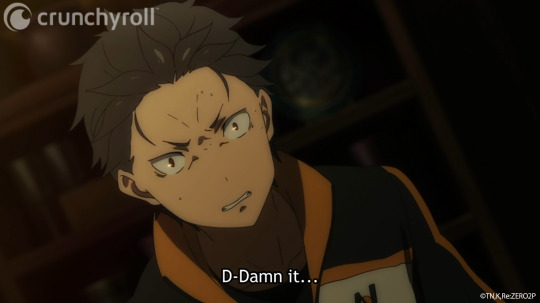
Death #2: Sliced Up by Elsa Granhiert, Again (beginning about 21:40 minutes into Episode 1B).
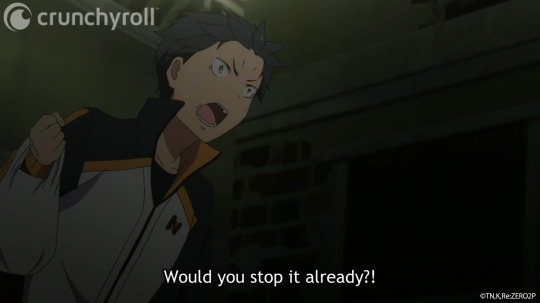
Death #3: Stabbed by Street Punks (beginning about 3:20 minutes into Episode 2).
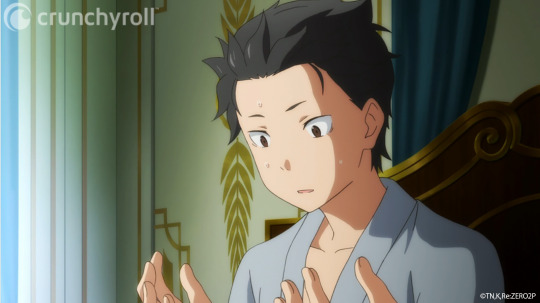
Death #4: As-Yet-Undefined Death In the Evening Hours (beginning about 23:55 minutes into Episode 4).
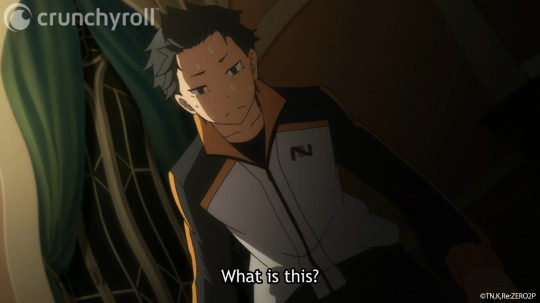
Death #5: Magical Curse + Bonus Bludgeoning by Unknown Assailant (beginning about 22:50 minutes into Episode 5).
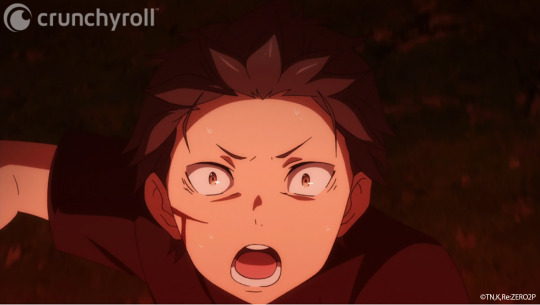
Death #6: Bludgeoned by Rem and Sliced Up by Ram (beginning about 1:15 minutes into Episode 7).
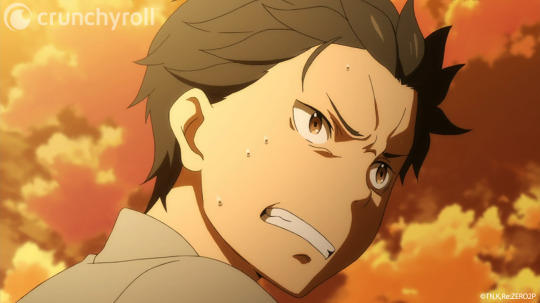
Death #7: Unlicensed Cliff-Diving (beginning about 23:50 minutes into Episode 7).
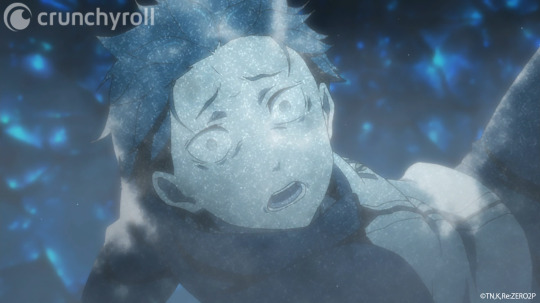
Death #8: Popsicle Impression (beginning about 2:25 minutes into Episode 15).
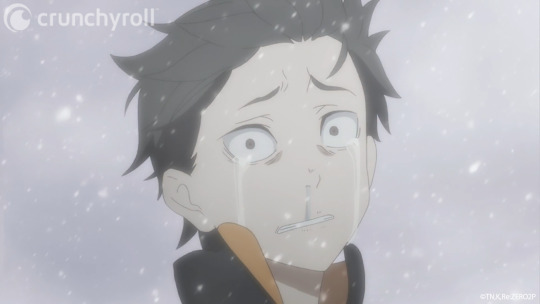
Death #9: Freezing Decapitation Double Whammy (beginning about 21:10 minutes into Episode 15).
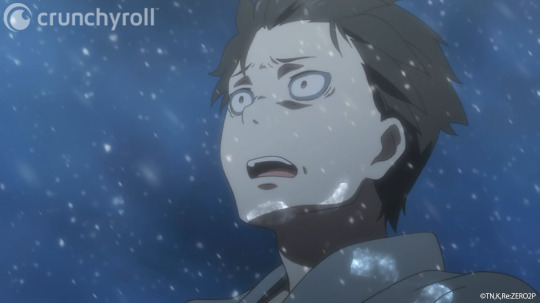
Death #10: Frozen Solid & Smashed to Pieces by Puck (beginning about 2:10 minutes into Episode 18).
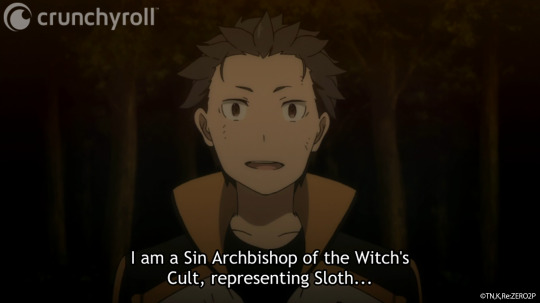
Death #11: Magic & Sword Assisted Suicide to End Petelgeuse's Possession (beginning about 21:10 minutes into Episode 23).

Death #12 from Season 2: Reenacting Romeo & Juliet While Trying to Rescue Rem (beginning about 13:10 minutes into Episode 26).

Death #13: Sliced Up by Elsa Granhiert, Once More, With Feeling (beginning about 25:20 minutes into Episode 30).
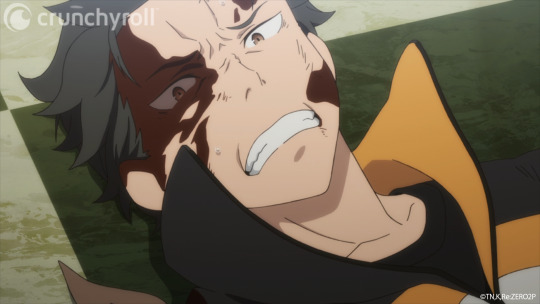
Death #14: Sliced Up by Elsa Granhiert, Part IV: The Revenge (beginning about 4:35 minutes into Episode 32).
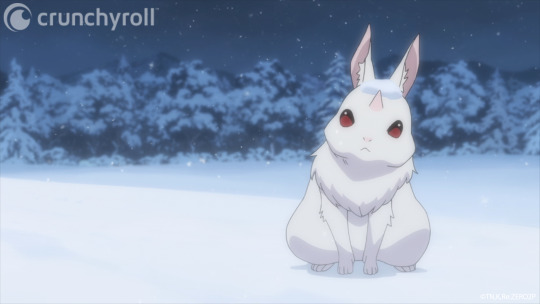
Death #15: Monty Python and the Holy Grail (beginning about 15:55 minutes into Episode 33).
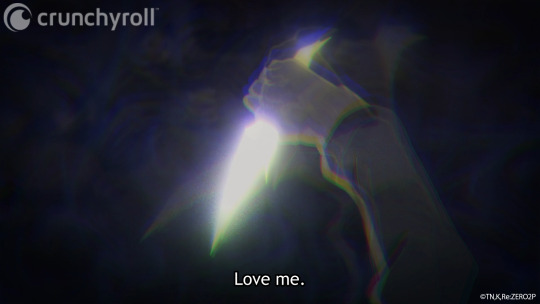
Death #16: Self-Inflicted Stab Wound to Escape Satella's Grasp (beginning about 3:00 minutes into Episode 35).

Death #17: Exsanguination from Countless Bunny Nibbles (beginning about 24:35 minutes into Episode 36).
They say that what doesn't kill you makes you stronger, but that old adage doesn't really take the effects of “Return by Death” into account. Luckily for the viewers, Subaru persists despite the constant threat of death and dismemberment, growing as a person and becoming more nuanced as a character with every incarnation, involuntary or otherwise.
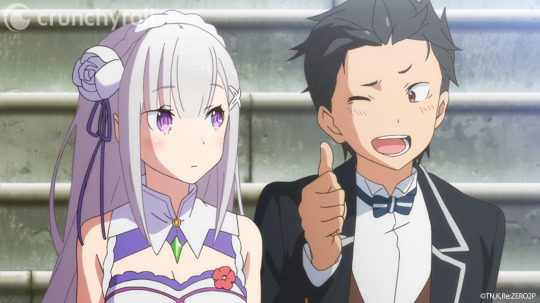
Special thanks go to Kara Dennison and Kevin Matyi for chronicling the lifes and deaths of poor Natsuki Subaru. If you'd like a little more Re:ZERO in your life, you can always check out the GREAT CRUNCHYROLL Re:ZERO REWATCH where Crunchyroll's writers explored the series. The second season of Re:ZERO -Starting Life in Another World- is currently streaming on Crunchyroll, and English language versions of the original Re:ZERO light novels are available from Yen Press.
What's your favorite (or least favorite) manner of Subaru being sent to meet his maker? Which scenes did you find particularly visceral or dramatic? Let us know in the comments section below, and stay safe out there, isekai fantasy light novel fans!

Paul Chapman is the host of The Greatest Movie EVER! Podcast and GME! Anime Fun Time.
Do you love writing? Do you love anime? If you have an idea for a features story, pitch it to Crunchyroll Features.
By: Paul Chapman
5 notes
·
View notes
Text
REVIEW: The Promised Neverland Live-Action Movie Looks Wrong but Feels Right

All images via Toho
Adapting stories from one medium to another is more art than science. There is no checklist you can follow that would allow you to always get it right. But if there is one rule that adaptations should keep in mind, it’s that as long as you understand the essence of the original story and know how to get it across accurately, then you can allow yourself to go a bit off-script on the details. The live-action version of The Promised Neverland, which premiered on December 18, 2020, seems to get it.
One of the biggest differences noticeable throughout the film is in nearly all of the characters. The protagonists are teenagers, not children. In the manga and anime, Emma, Norman, and Ray — who live in the idyllic Grace Field House orphanage that secretly raises kids as food for demons — are all 11, but in the movie, they’re 15.

This might seem like it would undermine the point of The Promised Neverland, which was like a dark, twisted fairytale or a Peter Pan-esque story — the kind of story that usually stars younger kids — but the teenaged characters still exude a very child-like energy of wonder, spiritedness, and determination because, well, they were raised in total isolation on a tiny paradise plantation since birth. It makes sense that they'd be a little childish. So despite being older, these are still the people you know and love.

There has, however, been some discussion about one of the movie’s other casting choices. Sister Krone, who is a Black character, is played by Naomi Watanabe, who very much isn’t Black. This is definitely problematic, especially considering there aren’t that many roles for Black people in Japanese movies to begin with. It’s hard to defend The Promised Neverland’s casting choice in this instance. This isn't to say that Watanabe doesn't do a great job with the character. She is a very talented comedian and she brings all of Krone’s maniacal energy to life flawlessly while hilariously mugging for the camera. In a story about murdering children for meat, she actually manages to get a couple of laughs from the audience, which is extremely impressive. Still, talent aside, we can't ignore the fact that this role could have gone to an equally talented Black actor.

Another huge casting difference arises with Isabella, the orphanage’s caretaker whom the children call “Mom.” In the anime, she was a genuinely sweet and kind person on the surface, full of warmth and compassion, which made it all the more shocking and uncomfortable when it turned out she was willingly sending her children to the slaughter. The live-action Isabella is played by Keiko Kitagawa, a phenomenal actress (please check her out in Mop Girl), but here, she plays the children’s Mom very reservedly. From her first moment on screen, it looks like she is barely hiding her darkness behind a half-smile and a soft voice. This is never reminiscent of the character in the original comic or animated series where the disconnect between her outwardly kind appearance and her monstrous actions made the character. It feels unfortunate not to have that in this movie.

We never really get to see a lot of the demons throughout the film, but maybe that’s for the best, because their CGI isn’t that great. Then there is the issue of the movie's runtime. Cramming the entire story from the 12-episode anime into just a little under two hours was bound to cause problems. For one, we never got to know Conny, the little girl who is killed early in the story, thus revealing the orphanage’s real nature to Emma and Norman. In the anime, we got tons of little scenes that helped us instantly understand the character, from how Emma would say “Good morning” to Conny’s stuffed bunny to how she played tag. All of this has been cut from the live-action movie for time, which sadly robs the story of a lot of emotion. But it almost feels like the movie is aware of that and tries to make up for it through the strategic use of the story's moral, while also using its limited runtime to its advantage.

An important part of The Promised Neverland story is not giving up hope even in the face of seemingly impossible odds. The original message didn't feel very deep to me and didn’t leave a massive impact as it was stretched over many episodes. In the movie, it is given center stage and is made the story’s guiding message. It’s also explored in a bit more detail, with the film debating through its characters about the benefits of not fighting against death and instead enjoying the time you have left on Earth. In Yuichiro Hirakawa’s The Promised Neverland, hopelessness and resignation are alluring and tempting, and it is heartbreaking watching such young characters seemingly give in to them. At the same time, it also makes it that much sweeter when it turns out that they stood strong and still retained hope. These emotionally packed scenes are also when the actors deliver their hands-down best performances in the movie. Despite some of its flaws, The Promised Neverland is a story about the triumph of hope, which feels exactly like what we need right now. If that sounds like something you would enjoy, definitely check out the live-action The Promised Neverland.
Are you planning to watch the live-action The Promised Neverland? Which scenes are you looking forward to the most? Let us know in the comment section!

Cezary writes words on the internet. You should follow him on Twitter.
Do you love writing? Do you love anime? If you have an idea for a features story, pitch it to Crunchyroll Features!
By: Cezary Strusiewicz
0 notes
Text
FEATURE: Chill Out with Every Naruto Closing Animation

Great music is key to adapting a popular manga into an anime series. And while the opening animations and themes get the lion's share of the attention, the ending animations and themes are equally important because they place a punctuation mark on the conclusion of each episode.
Crunchyroll has got all you music-lovers covered with a special video (below) that collects all of the closing animations from the 2002-2007 Naruto TV anime, which is based on the landmark shonen action manga by Masashi Kishimoto. The video contains 15 songs, including:
"Wind" by Akeboshi (from 0:00 to 1:30)
"Harmonia" by RYTHEM (from 1:31 to 3:01)
"Viva★Rock ~ japanese side ~" by ORANGE RANGE (from 3:02 to 4:32)
"ALIVE" by Raiko (from 4:33 to 6:10)
"Ima made nando mo" ("Many Times Before") by The Mass Missile (from 6:11 to 7:39)
"Ryusei" ("Falling Star") by TiA (from 7:40 to 9:08)
"Mountain-a-Go-Go-Two" by Captain Straydum (from 9:09 to 10:38)
"Hajimete kimi to shabetta" ("The First Time I Spoke with You") by GaGaGa SP (from 10:39 to 12:07)
"Nakushita kotoba" ("Lost Words") by No Regret Life (from 12:08 to 13:38)
"Speed" by Analogue Fish (from 13:39 to 15:07)
"Soba ni iru kara" ("Because You are With Me") by AMADORI (from 15:08 to 16:38)
"Parade" by CHABA (from 16:39 to 18:08)
"Yellow Moon" by Akeboshi (from 18:09 to 19:38)
"Pinocchio" by Ore Ska Band (from 19:39 to 21:08)
"Scenario" by SABOTEN (from 21:09 to 22:38)
youtube
It's practically a meme that in anime, the opening animations are hard rock while the ending animations are Swedish pop, and overall Naruto obeys that pattern. While the OP animations chronicle the main story-line of the series, the ED animations explore the emotional interiority of the main characters, focusing on both harsh and happy memories as well as unrequited romance to establish a more contemplative mood. The artwork is also more experimental, often drawing characters in a cartoony style or placing them in ordinary, everyday settings to emphasize the contrast between the Ninja World and our own.
My favorite ending animation is "Viva★Rock ~ japanese side ~" because I enjoy the chibi ninjas marching with such confidence and because the song has a catchy beat. What are your favorite Naruto ending animations and theme songs? Were you prepared for sway-dancing Ino and Sakura? What's up with the dog costumes? Let us know in the comments section below, and if you haven't experienced it already, be sure to check out Naruto, which is currently streaming on Crunchyroll.

Paul Chapman is the host of The Greatest Movie EVER! Podcast and GME! Anime Fun Time.
Do you love writing? Do you love anime? If you have an idea for a features story, pitch it to Crunchyroll Features!
0 notes
Text
FEATURE: Every Time that Subaru Dies in Re:ZERO -Starting Life in Another World-
Content and Spoiler Warning: This article contains huge spoilers for the first season of Re:ZERO -Starting Life in Another World-. It also contains references to death (in various gruesome flavors), violence, and suicide, so reader discretion is strongly advised.
If you're familiar with the premise of Re:ZERO -Starting Life in Another World- (aka “Anime Groundhog Day,” hereafter Re:ZERO), then you know that for reasons that yet remain mysterious and that likely involve witchcraft, the hero of the show, Natsuki Subaru, has a pretty rough time after he ends up in a fantasy world with a limited form of reincarnation.
Every time Subaru dies, the timeline resets from his perspective to an earlier “save point,” allowing him to re-live scenarios and attempt to alter their outcome for the better. The process is far from perfect and often horrendously painful, as only Subaru retains his memories from defunct timelines, and he's unable to communicate the experience of this phenomenon to his friends, allies, and loved ones.
youtube
With that in mind, we here at Crunchyroll have chronicled every time that Subaru expires, passes on, rings down the curtain and joins the choir invisible in the first season of Re:ZERO for the edification of our faithful viewers. Don't fret, folks. No matter how hard Subaru kicks the bucket, he always has another chance to start life in another world from zero.
Please note that all of the demises chronicled here use the time-stamps of the original release of Re:ZERO, rather than the Director's Cut. And now, without further ado, the Many Deaths of Subaru Natsuki, Isekai Fantasy Light Novel Protagonist:

Death #1: Sliced Up by Elsa Granhiert (beginning about 3:05 minutes into Episode 1B).

Death #2: Sliced Up by Elsa Granhiert, Again (beginning about 21:40 minutes into Episode 1B).

Death #3: Stabbed by Street Punks (beginning about 3:20 minutes into Episode 2).

Death #4: As-Yet-Undefined Death In the Evening Hours (beginning about 23:55 minutes into Episode 4).

Death #5: Magical Curse + Bonus Bludgeoning by Unknown Assailant (beginning about 22:50 minutes into Episode 5).

Death #6: Bludgeoned to Bits by Rem (beginning about 1:15 minutes into Episode 7).

Death #7: Unlicensed Cliff-Diving (beginning about 23:50 minutes into Episode 7).

Death #8: Popsicle Impression (beginning about 2:25 minutes into Episode 15).

Death #9: Freezing Decapitation Double Whammy (beginning about 21:10 minutes into Episode 15).

Death #10: Frozen Solid & Smashed to Pieces by Puck (beginning about 2:10 minutes into Episode 18).

Death #11: Magic & Sword Assisted Suicide to End Petelgeuse's Possession (beginning about 21:10 minutes into Episode 23).

BONUS ROUND! Death #12 from Season 2: Reenacting Romeo & Juliet While Trying to Rescue Rem (beginning about 13:10 minutes into Episode 26).
They say that what doesn't kill you makes you stronger, but that old adage doesn't really take the effects of “Return by Death” into account. Luckily for the viewers, Subaru persists despite the constant threat of death and dismemberment, growing as a person and becoming more nuanced as a character with every incarnation, involuntary or otherwise.

Special thanks go to Kara Dennison and Kevin Matyi for chronicling the lifes and deaths of poor Natsuki Subaru. If you'd like a little more Re:ZERO in your life, you can always check out the GREAT CRUNCHYROLL Re:ZERO REWATCH where Crunchyroll's writers explored the series. The second season of Re:ZERO -Starting Life in Another World- is currently streaming on Crunchyroll, and English language versions of the original Re:ZERO light novels are available from Yen Press.
What's your favorite (or least favorite) manner of Subaru being sent to meet his maker? Which scenes did you find particularly visceral or dramatic? Let us know in the comments section below, and stay safe out there, isekai fantasy light novel fans!

Paul Chapman is the host of The Greatest Movie EVER! Podcast and GME! Anime Fun Time.
0 notes